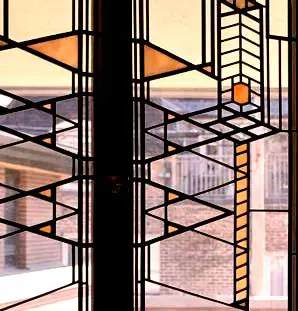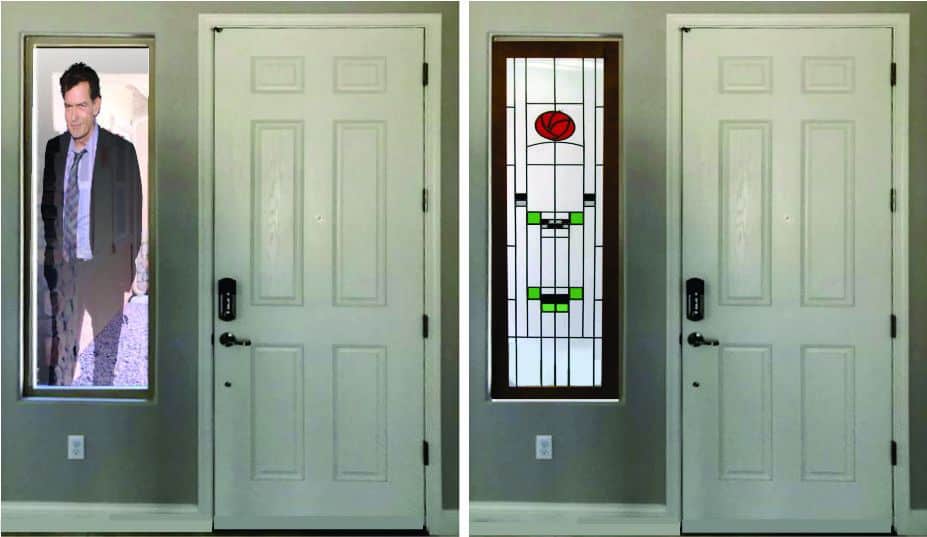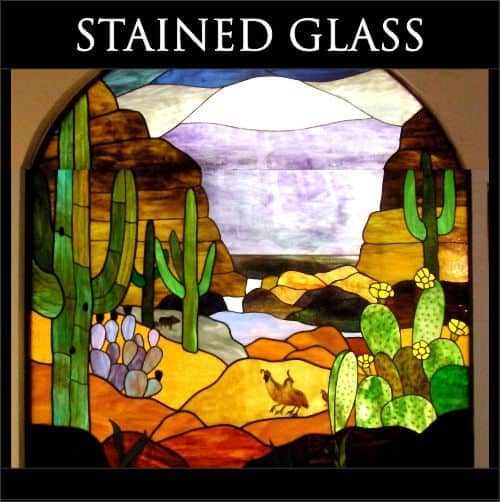Stained glass was once used almost exclusively to glorify God in the world’s most iconic cathedrals and houses of worship. Colored glass was also used to create household items like vases, flasks, and lamps. Stained glass has a long and fascinating history but today’s function has expanded from the purely religious to include residential and corporate decoration.
So, how is stained glass used today? Today, stained glass is used to add a custom decorative touch to individual homes and commercial buildings. It provides an immense amount of beauty and abstract color while also protecting a homeowner’s privacy. Stained glass is now used in the form of windows, lamps, panels, and window hangings.
To understand how stained glass progressed to where it is today, you have to understand the complete history. So, we’re going to explain the history of stained glass, important phases during its history, and how it’s used today!
A Brief History of Stained Glass
The first examples of colored glass were created in ancient Egypt and other parts of the Middle East and used mainly to create decorative objects like beads. By Roman times, glass was in wide use for drinking vessels and ornaments.
The further evolution of glass diverged in an interesting manner with Italian craftsmen in Murano developing fine crystal drinking glasses, whereas northern Europeans (possibly as a result of the colder climate) developed sheets of clear and colored window glass.

Christ telling the Good Samaritan parable to a couple of Pharisees – Detail from stained glass in Chartres Cathedral – circa 1215 CE
At first, opportunities for glass windows in churches were limited because early Romanesque Cathedrals needed massive walls to support their enormous weight. However, by the 12th century, the invention of flying buttresses strengthened the walls sufficiently to allow the construction of large windows that became the site of the most impressive stained glass that the world has ever seen. Stained glass eventually came to be used in all the great Gothic cathedrals of Europe – where its function was to illustrate Christian parables to unlettered peasants, to act as an allegory for God – shining his light from the heavens through breathtaking stained glass windows – the windows were the Bible written in light.
After Medieval times, stained glass declined in importance before, once again, gaining popularity – in the late-Victorian Neo-Gothic period
Neo-Gothic: Stained Glass Art Reborn
The Gothic revival, stimulated by a renewal of interest in Medieval history and the influence of High Anglican & Catholic culture in Europe resulted in religious and civic buildings with architectural elements such as steeply inclined roofs, pointed arches, and fancy carvings.

The stained glass craftsmen working in the neo-Gothic style imitated the color palette of Chartres, principally red and blue, with minor splashes of secondary colors. They reproduced the forms, with medallion windows in the aisles, and they imitated medieval figure drawing. Since the ideal in the church was a “subdued spiritual light” they copied the patina of age with silver-stain glass painting.
The neo-Gothic style remained popular throughout the Victorian period but was superceded by the Art Nouveau movement in the 1890s.
Art Nouveau Stained Glass
In the 1890s, Art Nouveau stained glass was the glass artist’s reflection of impressionism. The dominant exponent of the art form was the great Louis Confort Tiffany who was trained as an artist in France then returned to the US to run the family jewelry and design business,
In a series of daring and innovative business moves, he first purchased the patent for the new “copper-foil” method of stained glass production – which permitted the building of very detailed glass windows and lampshades.
He followed this by hiring the English glassmaker Arthur John Nash and collaborated with him to produce an amazing range of new textured and colored glasses including opalescent, favrile, ripple, ring-mottle, drapery and fracture-streamer glass. These exciting new colored glasses were used by Tiffany with great flair to simulate nature (shimmering water and sky) in impressionist-styled windows and glass lampshades.

· · · Memorial window, Louis Comfort Tiffany circa mid 1920s
Prairie-Style Stained Glass
Following the decline of Art Nouveau in the 1920s, Prairie-style stained glass made its first impression on Americans thanks to the architect Frank Lloyd Wright.
Wright designed his windows mainly with the use of clear glass and only minor touches of color. The windows were conceived as organic extensions to the buildings – long screens of light that blurred the distinction between the inside and outside of the homes. In detail, the designs mimicked nature with slender plant stems and abstract chevrons simulating corn. Tones were subdued and natural with pale amber, yellow, and greens predominating.

In Scotland, Charles Rennie MacKintosh, a contemporary of Wright, produced similarly stylish windows but identified with his signature red rose.
Today’s Uses
Today, stained glass is more popular than it has ever been. That’s probably because you can practically design your own custom stained glass to meet your style preferences, dimensions of your windows, and color requests.
Stained glass used to be ubiquitous in churches and cathedrals, but stained glass has steadily transitioned over to personal residences. It’s known for providing incredible beauty and color to a home while also allowing homeowners to have privacy and view control at the same time.
What are the benefits of stained glass?
There’s no doubt about it; stained glass is definitely a pricey addition to any home. However, it’s well worth the money if you value authentic and custom art! The most important feature is the color that stained glass art can add to a room. Whether it’s simply hanging on a wall in the form of a small panel or the sun is beaming through a stained glass window, it’ll be hard for guests to miss the impact your stained glass has on your home’s decor.
Stained glass can also offer an impressive amount of privacy. By creating a design that incorporates textured glass or even etched glass, you can obscure the view of outsiders and keep snoopers or peeping Toms at a distance. That’s why stained glass is the perfect fit for home entryways and bathrooms.

Even though you’re spending a decent chunk of change on your stained glass, that doesn’t mean that you won’t be making your money back in the future. Stained glass can actually add to your home’s market value and has a relatively high resale rate when sold on its own!
Types of Stained Glass Pieces
You’ve probably seen stained glass windows lining the halls of churches and cathedrals across the globe, but stained glass also comes in quite a few forms.
There are a few types of stained glass windows. Some windows are used entirely in place of other windows, while others are simply stained glass pieces adhered to the interior of an already-existing window. This prevents the need for any type of demolition and can easily be replaced with a little elbow grease.
Stained glass also comes in the form of panels, which are basically just small pieces of stained glass that aren’t meant to be used as windows. They can be hung high on your walls, hung in a window that gets a decent amount of light, or just leaned up on a countertop.
But, don’t forget about the other uses of stained glass. It can be used to make beautiful vases, glasses, or even lamps. Today, stained glass finds its way into just about every room of the home.
Custom Design
There’s no doubt that you can look on Etsy, eBay, or even Amazon to find premade pieces of stained glass, but the benefit of stained glass is that you can design your own! You can choose colors, line types, styles, and especially the size that fits perfectly in your home or in a specific room.
This does require a little extra money and time and for you to commission a skilled artist, but it’s the only real way to get exactly what you’re looking for in a piece of stained glass. And, if we know anything about 2020, people like things created exactly how they like them.
To learn about designing stained glass in Tucson, follow this link: Guide to the design of abstract stained glass.
What is the beauty of antique stained glass?

Today, antique stained glass is perhaps just as popular as brand new custom stained glass. Antique stained glass holds incredible value and offers an authentic and antique look to any room or home. Many people actually consider themselves to be stained glass collectors. Many antique stores sell stained glass with slight defects that can easily be restored – watch this video for information on stained glass repair.
Conclusion
Stained glass has a unique history, adjusting to just about every period of art since it was first discovered millennia ago. It went from being used to create traditional Egyptian beads to then to illustrate the bible in European Gothic cathedrals to finally being developed into modern and geometric designs in smaller panels.
Today, stained glass provides a custom and exotic feel to homes across the globe. It can be found in the form of panels, windows, or even lamps and adds substantial value and a luxurious appearance to any home.
All you need to know about art glass
Commissioning stained and etched glass
- Stained glass designs from Artistry in Glass
- How to commission a stained glass window – complete advice
- How to commission an etched glass window
- How to choose the best stained glass design
- Etched or stained glass – which is better for your home?
- How much does stained glass cost?
- How much does etched glass cost?
Technical information
- Is leaded glass dangerous? Learn the facts.
- How to replace broken patio table glass
- Plexiglass and glass – what are the pros and cons?
- What is plexiglass used for?
- What costs more – glass or plexiglass?
- Preservation of stained glass in churches & synagogues
- How does stained glass get colored? learn from an expert!
- Is your broken stained glass panel worth repairing?
- How to protect stained glass in religious buildings
- How to care for and clean stained glass
- How to repair cracked stained glass
- What is Dalle de Verre?
- How to repair Dalle de Verre
- What to do about bowed & sagging stained glass
- How to care for a stained glass skylight
- Can my stained glass lampshade be repaired?
- What is the difference between sandblasting & etching?
- Obscure and frosted glass – all you need to know!
- How to save money when buying glass
- Glossary of important terms used in decorative glass
- 14 Ways to sell stained glass
- What is imitation or faux stained glass?



